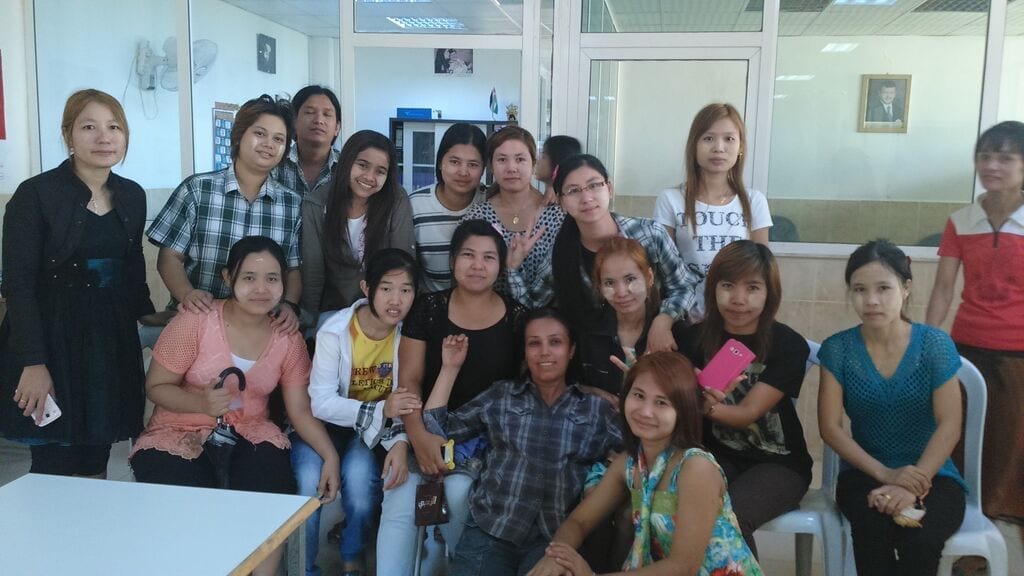
Oct 20, 2015
The “Made in Jordan” label is familiar to U.S. consumers shopping for shirts, jeans and other clothes. Mervat Jumhawi, a Jordanian union organizer, is actively ensuring the largely migrant workforce that cuts and sews these garments does so in safe conditions, receives fair wages and is treated with respect on the job.
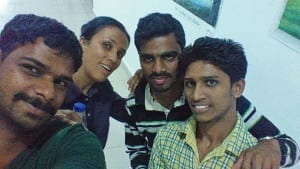
Mervat Jumhawi in a selfie wih Indian textile workers. Photo courtesy Mervat Jumhawi
“I was a garment worker and I know what exploitation is, I knows what that means,” says Jumhawi. After working 13 years in textile factories, Jumhawi spent six years on the board of the General Trade Union of Workers in Textile, Garment and Clothing Industries, where she served until recently. The union represents all 55,000 textile workers throughout Jordan, including migrant workers who comprise 71 percent of the country’s garment factory workforce.
Garment exports, produced primarily for the United States, account for some 20 percent of the country’s gross domestic product, with factories located in the Sahab, Dulail and Ramtha industrial zones.
“In the beginning, I was not familiar with migrant worker issues,” Jumhawi says, speaking through a translator. “But after I worked with migrant workers, I was more interested in their issues because they are more marginalized and vulnerable.”
Migrant Worker Exploitation Begins in the Home Country
Exploitation of migrant workers in Jordan and other countries around the world often begins in their home countries, where they typically pay huge fees to labor brokers for a job. Indebted when they start their employment, migrant workers often endure abusive conditions to pay off their loans. Employers also may confiscate passports, effectively holding migrant workers hostage and unable to leave if they are not paid or if they experience verbal or physical abuse. Jumhawi helps raise workers’ awareness of their rights under the law and assists workers who are not receiving health care, who have been abused or otherwise need assistance making their way through the legal system.
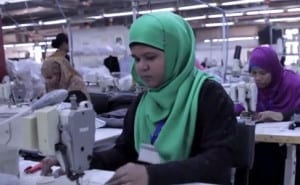
More than 70 percent of migrant textile workers in Jordan are women. Credit: Solidarity Center
More than 70 percent of migrant textile workers in Jordan are women, primarily from Bangladesh, Sri Lanka and Myanmar. Jumhawi’s one-on-one assistance with garment workers and her dedication to improving their working conditions—she spent 40 days and nights with 1,300 striking Burmese garment workers—has generated tremendous trust among the workers.
In one instance, when Bangladesh and Sri Lankan workers went on strike in 2013, Jumhawi tried to speak with managers, but they would not let her in the factory. As she left, she looked back, and saw hundreds of workers following her. Her challenge to management gave the workers strength, she said. Seeing the workers take off with Jumhawi in the lead, managers ultimately negotiated—but not until Jumhawi had talked with each worker to hear specific grievances.
Solidarity Center Support Assists Migrant Workers
The Solidarity Center provided support over the past year for the migrant outreach project among textile workers, holding trainings on combating labor trafficking and exploitation through collective worker action. Workers were encouraged to form committees to monitor labor rights violations and refer them to the union resolution.
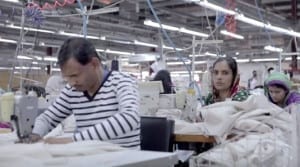
Of the 55,000 textile workers in Jordan, 71 percent are migrant workers. Credit: Solidarity Center
Over the years, the Solidarity Center also has worked closely with the garment workers union, and in May 2013, the union negotiated a contract with employers that covers all textile workers, including migrant workers. The contract set up health and safety committees, requires employer pay for transportation and food and prohibits labor recruiters in origin countries from charging fees to workers.
“Our union is keen on migrant worker issues from the moment they arrive in Jordan,” says Fathalla Al Omrani, garment workers’ union president.
Migrant workers are housed in employer-owned dormitories, which often fail to meet safety and health standards, according to Sara Khatib, a Jordan-based Solidarity Center program office for anti-trafficking initiatives. The contract requires employers follow Ministry of Health standards for living conditions, such as not overcrowding workers in a room.
“We were 10 to 12 women living in one room,” says one garment worker. “After the inspectors visit, the numbers decreased to six or seven.”
‘I Will Struggle for Migrant Workers to the End’
Supervisors yell at the workers if they don’t reach the production target and may deduct pay or even deport them, says Jumhawi. Such actions violate Jordan’s labor laws and the union contract.
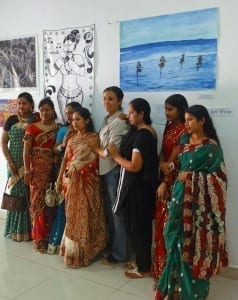
Mervat (center), joins women from Bangladesh, the largest group of migrant workers in Jordan’s textile industry. Photo courtesy Mervat Jumhawi
Jumhawi has been instrumental in helping workers enforce the contract and seek justice under Jordan’s labor laws. She also recently assisted with production of a video documenting migrant workers’ struggles in Jordan and the role of union strength in helping workers achieve their goals. When asked about her most important victories, she says she counts “every single and small achievement,” as a major success, “even helping a worker with a small thing.”
“Mervat is very close to the workers and they all trust her,” says Khatib, who works closely with Jumhawi. “She follows up on the workers’ cases seriously and she deeply cares about them. She’s a hard working woman and a real unionist.”
Jumhawi works 12 hour days, seven days a week, unless she is too tired or sick, she says. Sometimes the long hours and tough demands make her want to leave the job. But she changes her mind when she thinks of the workers.
“I will struggle for migrant workers to the end, and I encourage all workers, especially women, to become unionists. When I became member of the union, I became stronger.”
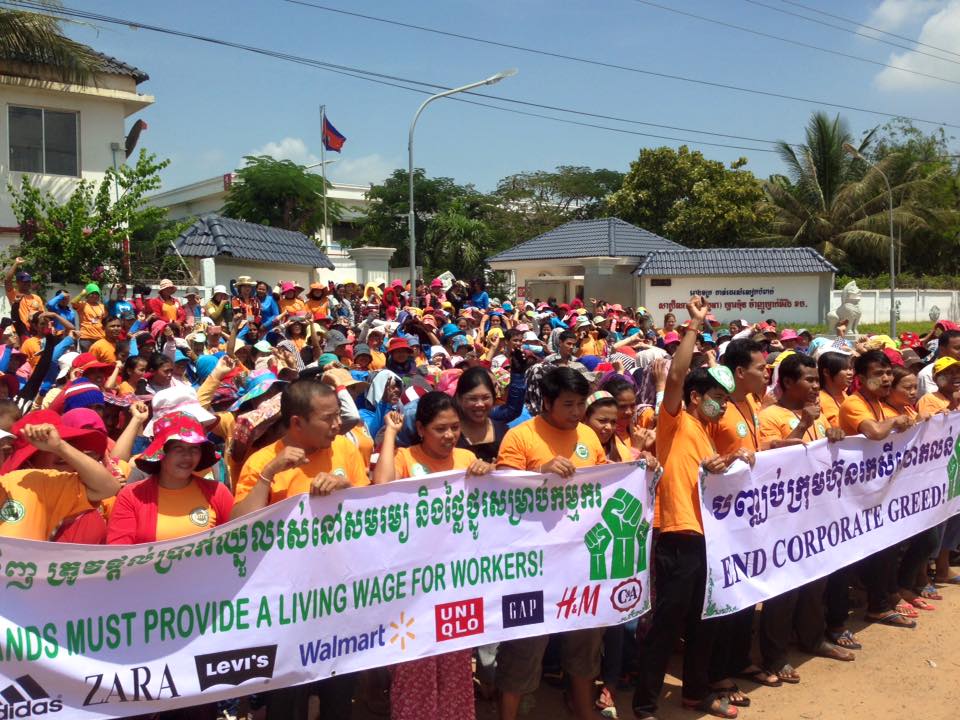
Oct 7, 2015
Some 21,000 garment workers from six unions at more than 60 factories across Cambodia dedicated their 30-minute lunch breaks to rallies calling for a higher minimum wage. The monthly minimum wage for garment and footwear workers is $128. Last year, Cambodia’s garment exports totaled $5.7 billion.
A recent study of garment workers and their expenditures, conducted by labor rights groups, including the Solidarity Center, indicates that the workers currently earn far less than they need to cover expenses.
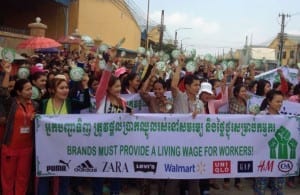
Garment workers from 60 factories around Cambodia devoted their 30-minute lunch breaks to rally on Decent Work Day. Credit: Solidarity Center/Khun Tharo
As part of the October 7 International Decent Work Day demonstrations around the theme, “End Corporate Greed,” workers from industrial areas in Phnom Penh, Sihanoukville, Kompong Spuer, Kandal and Svay Reing provinces held stickers and banners urging international brands to provide a decent living wage for Cambodian garment workers.
A working group of union representatives, employers and government officials has been meeting to determine a new 2016 minimum wage and are nearing a recommendation. The Coalition of Cambodian Apparel Workers Democratic Union (CCADWU) and other unions not affiliated with the government said that they will boycott the process if the recommendation does meet workers’ needs.
Over the past two years, tens of thousands of garment workers have taken to the streets in a series of strikes for minimum wage increases. In January 2014, Cambodian security forces shot into crowds of striking workers, killing at least five, injuring more than 60 and resulting in the arrests and dismissals of dozens of workers and union leaders.
Unions that took part in the Decent Work Day actions include the CCADWU, the Cambodian Alliance of Trade Unions, the Collective Union of Movement of Workers, the National Independent Federation of Textile Unions in Cambodia and Worker Freedom Union Federation.
The actions in Cambodia are part of worldwide activities around the world, with the International Trade Union Confederation reporting events in 33 countries at its World Day for Decent Work site.
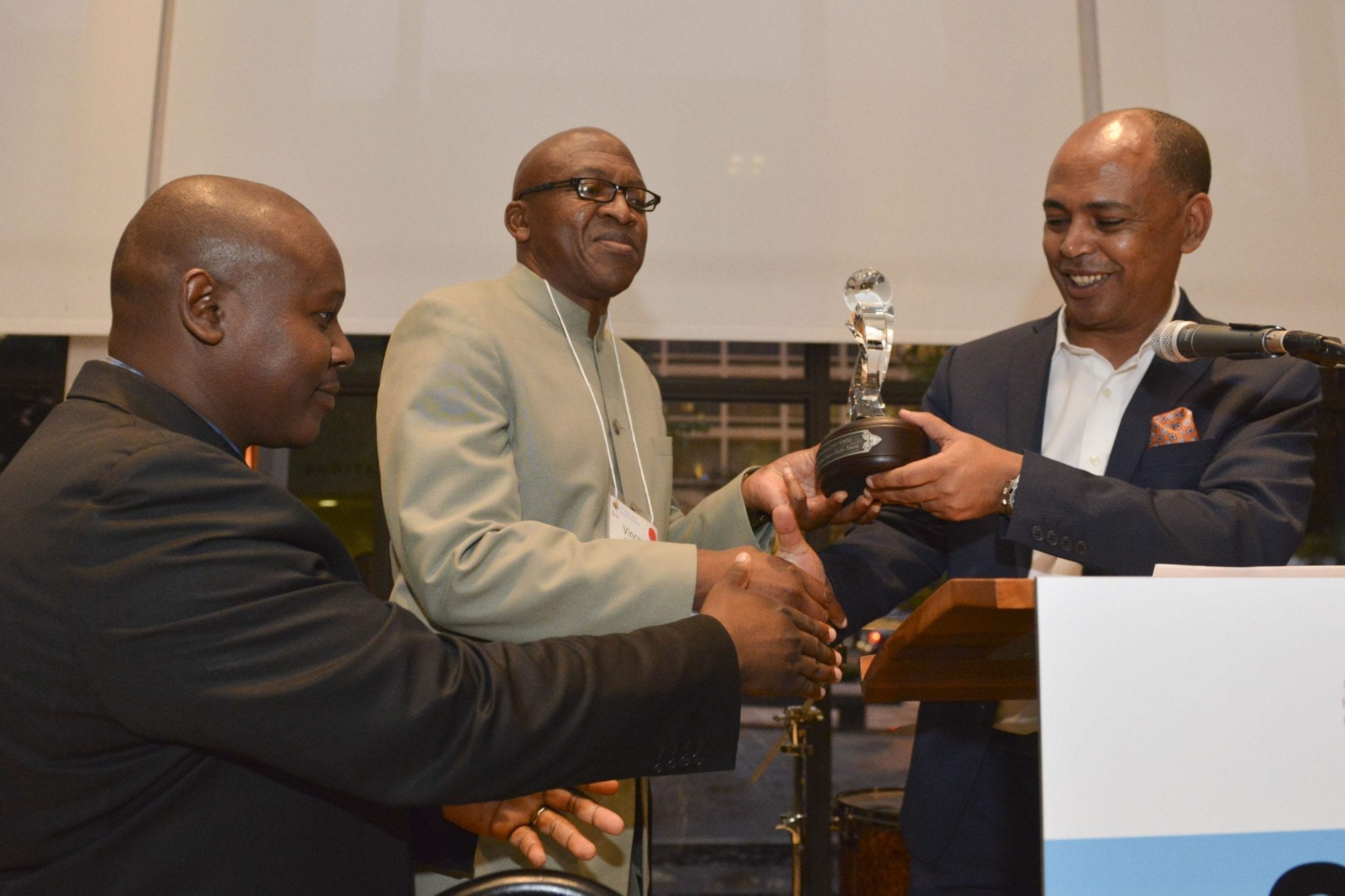
Oct 2, 2015
Over the past year, Swazi workers have not been deterred from taking part in union meetings even though the gatherings were repeatedly broken up by police. They turned out in large numbers for the annual May Day rally, although they were threatened with arrest if they did so. And they took all these actions in an environment in which unions were banned and free speech squelched.
For their bravery in standing up for their rights, Swazi workers and their union, the Trade Union Congress of Swaziland (TUCOSWA), last night received the AFL-CIO’s 2015 George Meany-Lane Kirkland Human Rights Award, which recognized “the courage and persistence of Swaziland’s workers in demanding their rights,” the AFL-CIO said in a statement announcing the award.
More than 200 union allies and supporters, including participants of the Global Labor University conference, packed the AFL-CIO lobby in Washington, D.C., for the honors ceremony, with TUCOSWA Secretary General Vincent Ncongwane and TUCOSWA Treasurer General Patrick Mamba accepting the award on behalf of the union and Swazi workers.
“Labor never quits,” Ncongwane said, accepting the award. “We never give up the fight, no matter how tough the odds, no matter how long it takes,” he said, quoting former AFL-CIO President George Meany.
“You’re truly global leaders for the struggle for justice,” said AFL-CIO Executive Vice President Tefere Gebre as he presented the award.
Speaking at the event, Jos Williams, president of the AFL-CIO Metropolitan Washington Labor Council, described his experience as part an International Trade Union Confederation (ITUC) fact-finding delegation to Swaziland in May. Members of the delegation were moved to tears during their meeting with families of imprisoned human rights leaders, Williams said.
“I saw tough freedom fighters with tears in their eyes once they heard from their families.”
TUCOSWA was formed in 2012 with the merger of the Swaziland Federation of Trade Unions and the Swaziland Federation of Labor. Both were joined by the Swaziland National Association of Teachers. TUCOSWA only received official recognition this past May, after the U.S. government suspended trade benefits with the country last year and made worker rights a key component of restoring its trade eligibility.
Since the U.S. government suspended Swaziland’s participation in the African Growth and Opportunity Act (AGOA), the country also has freed imprisoned human rights advocates but it has not yet repealed anti-terrorism laws that enable it to imprison union leaders and others who call for human rights and democracy.
At a briefing on working conditions in Swaziland at the Solidarity Center, Ncongwane noted that the loss of trade benefits has impacted thousands of workers, especially in the textile sector, who have been laid off.
Speaking last night, Ncongwane said “we are working tirelessly to press for reforms that will put our country on a more secure footing to restore these jobs and to restore job opportunities. The greatest threat to jobs and growth in Swaziland does not come from unions, but from our government’s lack of foresight, lack of vision and mismanaged policy decisions.”
Ncongwane emphasized the positive impact of global labor solidarity which, in publicizing the government’s actions, has enabled the union to operate with some measure of freedom.
“We will utilize our institutional strength to impact and press for change but we need our international partners in the global labor movement to maintain support for workers’ rights and for greater democracy in Swaziland, especially now when we are as close as we’ve ever been to real reform in years,” he said.
The annual Meany-Kirkland award, created in 1980 and named for the first two presidents of the AFL-CIO, recognizes outstanding examples of the international struggle for human rights through trade unions.
Last year, the Building and Wood Workers’ International (BWI) and its affiliates received the award and the International Domestic Workers Federation (IDWF) received it in 2013. In 2012, the award went to the Tunisian General Union of Labor (UGTT) and the General Federation of Bahrain Trade Unions (GBFTU)—two unions whose struggles were emblematic of labor’s role in the uprisings that year.
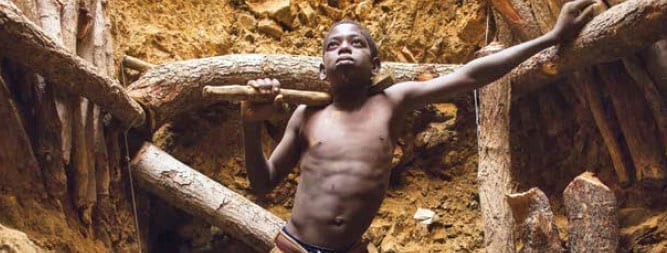
Oct 1, 2015
Karim Sawadogo is young enough to count his age on his hands, but instead he uses them to hack away at the dry, yellow earth in the hazardous mine shafts where he works in Burkina Faso. He has a few memories of what it’s like to be a child in school or at play. “My dream,” he says, “is to make enough money so I don’t have to do this anymore.”
Sawadogo is among 168 million child laborers around the world, 6 million of whom are estimated to toil in forced labor, according to the U.S. Department of Labor’s new report, “2014 Findings on the Worst Forms of Child Labor.” Some 85 million child laborers are engaged in hazardous work, such as digging gold mines and working in agricultural fields sprayed with toxic pesticides, the report states, citing the International Labor Organization (ILO).
Uzbekistan Retains Bottom Rank for Child Labor
Released yesterday, the report measures the commitment and progress made by governments to eliminate the worst forms of child labor—slavery or trafficked labor, bonded and forced labor, exploitive labor, hazardous work, commercial sexual exploitation and involvement in illicit economies. It ranks 140 countries on their progress since the 2013 report was released last October, from “No Advancement” to “Significant Advancement.” The rankings are based on assessments of meaningful efforts made my governments in the areas of laws and regulation, enforcement, coordination, government policies, and social programs.
The 2014 report ranks 13 countries as showing “Significant Advancement,” including seven in Latin America, four in Africa and two in Asia. Madagascar, Paraguay and Thailand increased their assessment level from “Moderate” in 2013 to “Significant” in 2014. Eritrea, South Sudan and Uzbekistan continue to rank at the bottom of assessed countries because of what the report cites as government complicity in forced child labor.
Sub-Saharan Africa again is the region with the highest incidence of child labor. An estimated 59 million children ages 5–17 are engaged in child labor, or more than one in five children in the region. Nearly 29 million of these child laborers are engaged in hazardous work.
Children Bear the Brunt of Trauma from World Crises
The report reflects on the call to action by 2014 Nobel Laureate and long-time Solidarity Center ally Kailash Satyarthi. “Let’s walk together. In the pursuit of global progress, not a single person should be left out or left behind in any corner of the world, from East to West, from South to North.”
Other notable findings from the report include:
- The Ebola outbreak in West Africa affected 5 million children, some of whom turned to work to support themselves or their families during the crisis.
- An estimated 1 million children were killed, injured, kept out of school, or trafficked as a result of the massive April 2015 earthquake in Nepal.
- Approximately 75 percent of school-aged Syrian refugees in Turkey were not enrolled in schools, making them vulnerable to forced labor and exploitive work.
The State Department this year released an accompanying app, Sweat & Toil: Child Labor, Forced Labor, and Human Trafficking around the World. Users can access a comprehensive database on child labor, searchable by country, goods, or exploitation types. “This report and the new mobile app are intended as practical tools,” says Deputy Secretary of Labor Christopher Lu, “to identify the problem and help governments around the world firm up the foundations of such protections, so that children don’t fall through the cracks.”
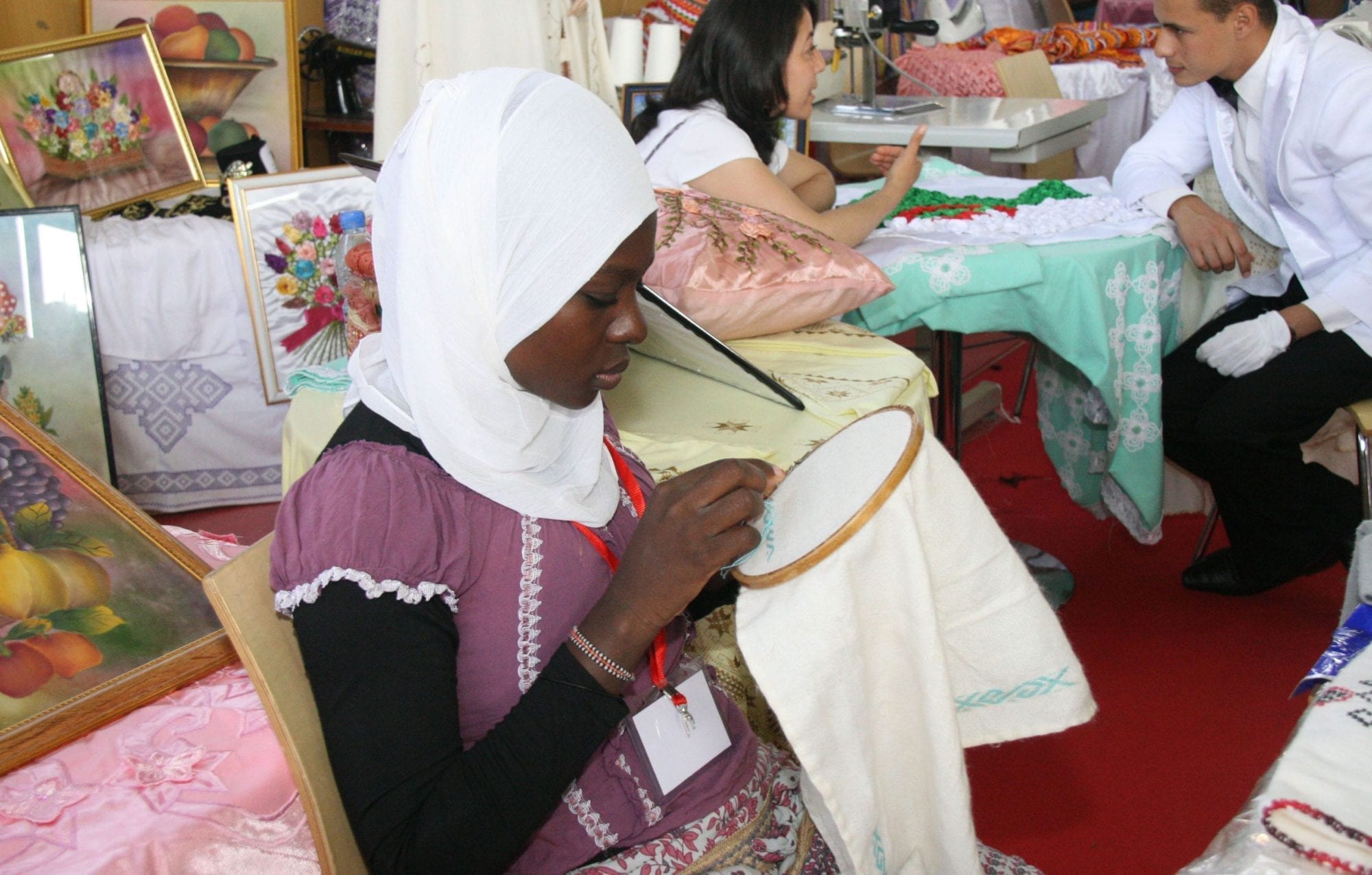
Sep 24, 2015
A vigil tonight at the United Nations kicks off events around the world body’s broad new 17-point agenda that aims in part to end extreme poverty, eradicate hunger and ensure clean water and sanitation. The 193 UN member states have debated the Sustainable Development Goals (SDGs) over past three years and in coming days likely will commit to work toward achieving them by 2030.
The 17 goals include 169 targets, an ambitious agenda whose success will depend upon governments and civil society working together, according to UN Secretary General Ban Ki Moon. But fundamental to the entire plan is Goal No. 8, “Decent Work and Economic Growth,” says Shawna Bader-Blau, Solidarity Center executive director.
“Pernicious economic and social inequality is most obvious where the rights of working people are most denied,” Bader-Blau wrote in a recent Huffington Post article. “And no effort to mitigate inequality within and among countries will succeed without a committed movement to protect and bolster those rights.”
Key Goals in Decent Work and Economic Growth
Decent Work and Economic Growth includes the following key goals:
- By 2030, achieve full and productive employment and decent work for all women and men, including for young people and persons with disabilities, and equal pay for work of equal value.
- By 2020, substantially reduce the proportion of youth not in employment, education or training.
- Take immediate and effective measures to eradicate forced labor, end modern slavery and human trafficking and secure the prohibition and elimination of the worst forms of child labor, including recruitment and use of child soldiers, and by 2025 end child labor in all its forms.
Another critical target is protecting worker rights and promoting safe and secure working environments for all workers, “including migrant workers, in particular women migrants, and those in precarious employment.”
“People should not have to leave their human rights at the border when they migrate,” Bader-Blau said this week on the Kojo Nnamdi radio show in Washington, D.C.
Gender Equality Essential for Broad-Based Prosperity
Achieving gender equality, Goal No. 5, also is essential to attaining broad-based prosperity. A new study released today estimates that tackling gender inequality and boosting women’s job opportunities could add $12 trillion to the annual gross domestic product (GNP).
The “Gender Equality” goal includes as one of its top targets the elimination of all forms of violence against women and girls in the public and private sphere—a scourge that is prevalent even in the workplace, where 30 percent to 40 percent of workers report gender-based violence, a figure that rises to 90 percent in some jobs.
Building accountable institutions and ensuring access to justice (Goal No. 16 and Goal No. 17), and implementing social protections systems, one of the targets of Goal No. 1, also are essential components of the new 15-year plan.
The SDGs replace the eight UN Millennium Development Goals (MDGs), which included halving extreme poverty, halting the spread of HIV/AIDS and providing universal primary education by 2015.










